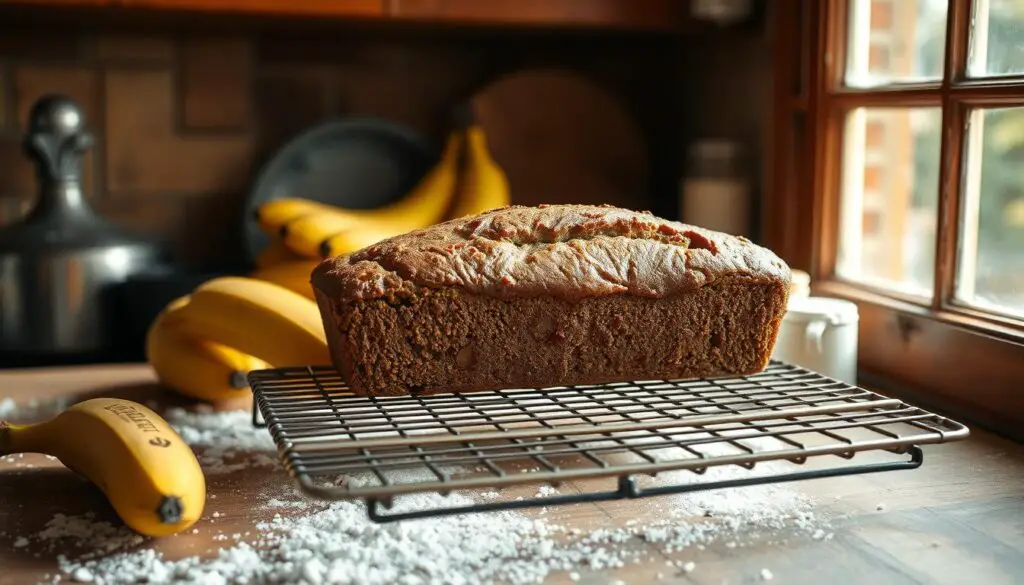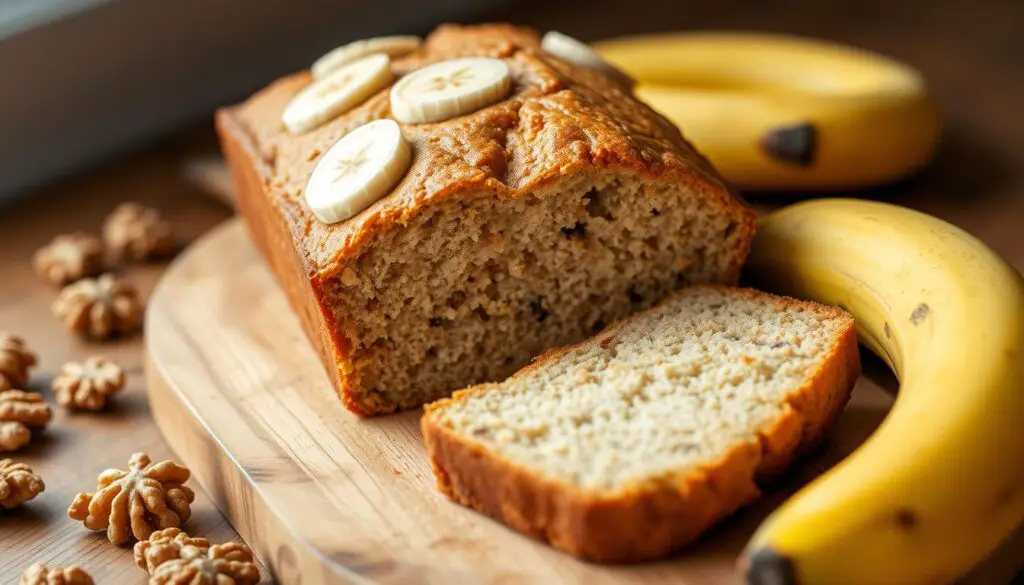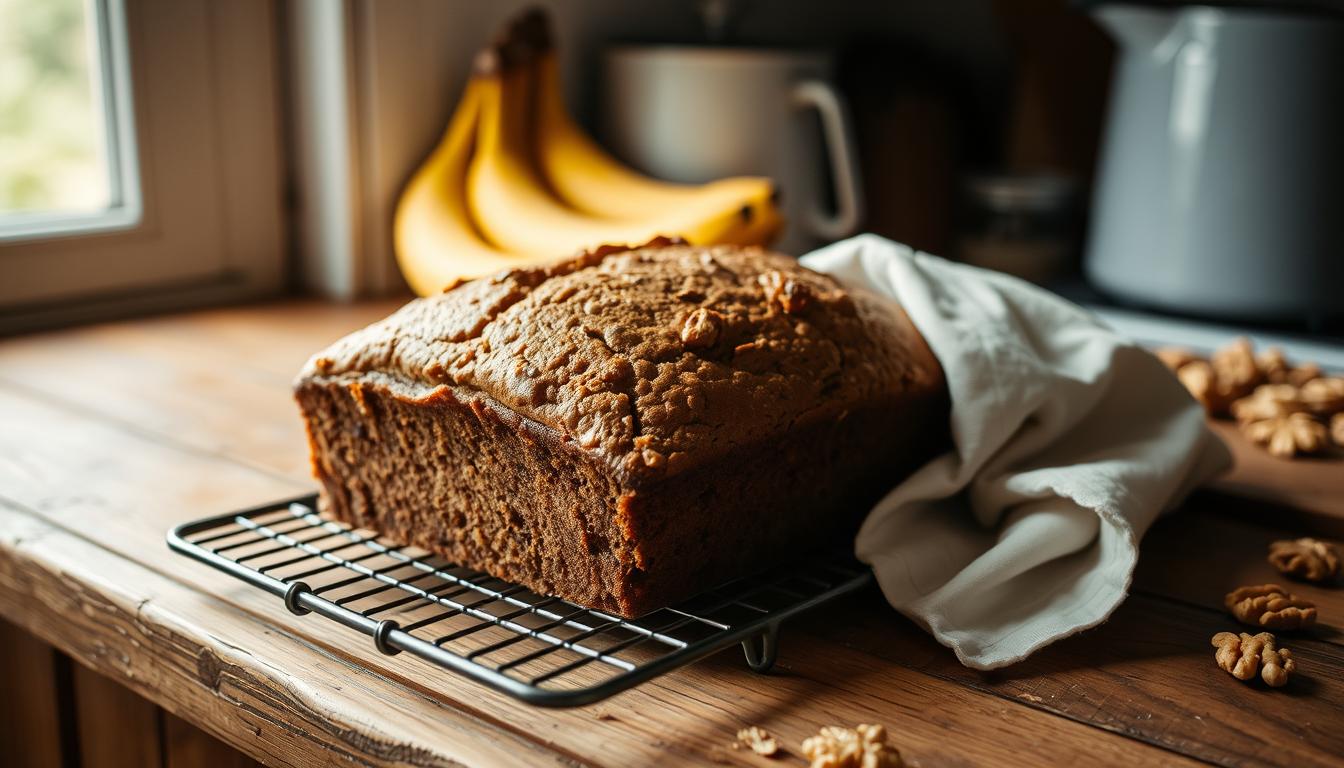Ah, the aroma of freshly baked banana bread wafting through the kitchen – it’s enough to make your mouth water. But before you dive in, you may be wondering: do you really have to let this delectable treat cool down first? The answer may surprise you.
Patience is often the key to achieving the perfect texture and flavor when it comes to baking. And when it comes to banana bread, allowing it to cool properly can make all the difference. In this article, we’ll explore the importance of cooling banana bread, the science behind it, and the best practices to ensure you get the most out of your homemade loaf.
Key Takeaways
- Cooling banana bread is essential to achieve the desired texture and flavor.
- The cooling process allows the bread to fully set and the flavors to develop.
- Cutting into banana bread too soon can result in a gummy, dense texture.
- Proper cooling techniques, such as using a cooling rack, can enhance the bread’s overall quality.
- Factors like pan material and recipe variations can impact the optimal cooling time.
Understanding the Cooling Process of Banana Bread
When it comes to the perfect warm banana bread, patience is key. Allowing your freshly baked loaf to cool properly is an essential step that shouldn’t be overlooked. Understanding the cooling process and how it affects the texture and flavor of your consuming banana bread can make all the difference in your eating banana loaf experience.
Importance of Cooling Down
Letting your banana bread cool down is crucial for several reasons. As the bread bakes, the internal temperature can reach up to 205°F (96°C), which is hot enough to continue cooking the center even after it’s been removed from the oven. Cutting into the bread too soon can result in a gummy, undercooked interior, as the residual heat hasn’t had a chance to fully dissipate.
Texture Changes During Cooling
During the cooling process, the texture of your banana bread undergoes a transformation. As the bread cools, the starches in the batter begin to crystallize, resulting in a firmer and more cohesive crumb. This cooling period also allows the gluten structure to set, preventing the bread from collapsing or becoming dense. Patience pays off, as the end result is a moist, tender, and perfectly textured warm banana bread.
| Cooling Stage | Texture Changes |
|---|---|
| Initial Cooling | Bread remains soft and pliable, with a moist interior. |
| Intermediate Cooling | Starches crystallize, creating a firmer, more cohesive crumb. |
| Final Cooling | Gluten structure sets, resulting in a moist and tender texture. |
By understanding the importance of the cooling process and the texture changes that occur, you can ensure your warm banana bread reaches its full potential, providing a delightful eating banana loaf experience for you and your loved ones.
The Science Behind Baking Temperatures
Understanding the science behind baking temperatures is key to producing the perfect ripe banana bread with a delightful, moist texture. The temperature at which you bake your banana bread not only affects its appearance but also plays a crucial role in developing its signature flavor.
How Heat Affects Flavor
As the banana bread bakes, the intense heat triggers a series of chemical reactions that transform the simple ingredients into a complex medley of flavors. The Maillard reaction, a process that occurs when sugars and amino acids are exposed to high temperatures, is responsible for the bread’s enticing aroma and caramelized crust. By carefully controlling the banana bread temperature, you can ensure the Maillard reaction is optimized, resulting in a deep, rich flavor profile.
The Role of Residual Heat
Even after the banana bread is removed from the oven, the baking process doesn’t stop. The residual heat continues to cook the interior of the loaf, allowing the flavors to further develop and the texture to become more cohesive. Allowing the bread to cool down slowly, rather than slicing into it immediately, enables this crucial stage of the baking process to occur, resulting in a more moist and flavorful final product.
“The key to a perfectly baked banana bread lies in understanding the science behind the temperatures and heat transfer.”
Ideal Cooling Times for Banana Bread
When it comes to banana bread preparation, one of the most critical steps is allowing the loaf to cool properly before slicing and enjoying. The ideal cooling time can vary depending on several factors, but following the recommended guidelines can help you achieve the perfect texture and flavor.
Recommended Cooling Duration
As a general rule, it’s best to let your banana bread cool for at least 30 minutes before attempting to slice it. This allows the internal structure of the bread to set and the flavors to develop fully. For larger loaves or denser banana bread recipes, you may want to extend the cooling time to 45 minutes or even an hour.
Factors That Influence Cooling Time
- Loaf Size: Larger banana bread loaves will take longer to cool compared to smaller ones.
- Ambient Temperature: If the room temperature is relatively cool, the cooling process will be slower than in a warmer environment.
- Oven Temperature: Bread baked at higher temperatures may require more time to cool down completely.
- Ingredients: Recipes with more moisture, such as those containing extra bananas or oil, may need a bit more time to cool.
By paying attention to these factors and allowing your banana bread to cool for the appropriate duration, you can ensure a perfectly moist and flavorful treat that’s ready to slice and enjoy.

Signs Your Banana Bread is Ready to Slice
Patience is key when it comes to enjoying a perfectly baked fresh baked banana bread. After taking your delightful loaf out of the oven, it’s crucial to allow it to cool properly before slicing into it. But how do you know when your banana bread cooling has reached the optimal point for serving? Let’s explore the visual cues and the importance of the toothpick test.
Visual Cues to Look For
As your fresh baked banana bread cools, there are a few telltale signs that it’s ready to be sliced and savored. Look for the following:
- The top of the bread should appear set and no longer shiny or wet.
- The sides of the loaf should have pulled away slightly from the pan, indicating that the bread has fully baked through.
- When gently pressed, the top of the bread should feel firm and spring back lightly, rather than feeling overly soft or squishy.
Importance of a Clean Toothpick Test
While visual cues can be helpful, the most reliable way to determine if your banana bread is ready for slicing is to perform the classic toothpick test. Simply insert a clean toothpick into the center of the loaf. If the toothpick comes out clean, with no batter or crumbs clinging to it, your banana bread is ready to enjoy.
Allowing your banana bread to cool completely before slicing ensures that the texture and flavor have had time to fully develop, resulting in a moist, tender, and delicious treat. So be patient, let your bread cool, and then dive in to savor every bite of your homemade masterpiece!
Benefits of Letting Banana Bread Cool
Allowing your freshly baked warm banana bread to cool down before slicing into it may seem like an eternity, but the wait is well worth it. This cooling process not only enhances the overall flavor development of your bread but also improves its texture and moisture retention.
Enhancing Flavor Development
As the warm banana bread cools, the flavors have time to meld and deepen. The sugars and spices in the recipe have a chance to caramelize, creating a richer, more complex taste. The banana aroma also becomes more pronounced, making each bite even more delightful.
Improving Texture and Moisture Retention
When you slice into a warm banana bread straight out of the oven, the texture can be a bit gummy or dense. But by allowing it to cool, the crumb structure has time to set, resulting in a moist and tender texture that melts in your mouth. The cooling process also helps the bread retain more of its natural moisture, preventing it from drying out too quickly.
So, the next time you bake a batch of delicious banana bread, be patient and let it cool before indulging. Your taste buds will thank you for the extra effort!
Common Mistakes When Cooling Banana Bread
Baking delectable banana bread is an art, but the journey doesn’t end when the loaf comes out of the oven. Properly cooling your banana bread is crucial to achieving the perfect texture and flavor. Unfortunately, many home bakers make common mistakes during this crucial step, compromising the quality of their beloved consuming banana bread or eating banana loaf.
Cutting Too Soon
One of the most common errors is slicing into the banana bread too soon after it comes out of the oven. While the temptation to dive in and enjoy a warm, fragrant slice is understandable, cutting the bread before it has had a chance to cool can lead to a gummy, dense texture. The interior of the loaf needs time to set and firm up, so it’s best to resist the urge and allow the bread to cool completely on a wire rack before slicing.
Storing Bread While Still Warm
Another misstep is storing the banana bread while it’s still warm. Putting a warm loaf into an airtight container or plastic bag can trap moisture, leading to a soggy, unappetizing texture. Instead, let the bread cool to room temperature before wrapping it up for storage. This helps preserve the bread’s soft, moist crumb and prevents it from becoming stale or developing an undesirable crust.
By being mindful of these common cooling mistakes, you can ensure that your homemade consuming banana bread or eating banana loaf reaches its full flavor and textural potential. With a little patience and the right cooling techniques, your banana bread will be irresistible.
How to Cool Banana Bread Properly
Properly cooling your freshly baked banana bread is crucial for achieving the perfect texture and flavor. By following a few simple best practices, you can ensure your banana bread preparation results in a delightful treat that’s worth the wait.
Best Practices for Cooling
The key to cooling banana bread is to be patient and resist the temptation to slice into it right away. As soon as the bread comes out of the oven, transfer it to a wire cooling rack. This allows air to circulate freely around the loaf, helping it cool evenly and preventing the bottom from becoming soggy.
- Let the banana bread cool for at least 15-20 minutes before attempting to remove it from the pan.
- Avoid placing the hot bread on a cold surface, as this can lead to cracking or uneven cooling.
- If you need to transport the bread, wait until it’s completely cool before handling it.
Recommended Cooling Racks and Tools
To ensure the banana bread cooling process is a success, invest in a quality cooling rack. Look for one with a sturdy metal frame and ample surface area to accommodate your full-size loaf. Some other helpful tools include:
- Silicone baking mats or parchment paper to line the cooling rack for easy cleanup
- A bread knife or serrated knife for slicing the cooled banana bread
- Airtight storage containers or resealable plastic bags to preserve freshness
“Patience is key when it comes to cooling banana bread. Rushing the process can result in a dense, gummy texture that detracts from the overall experience.”
By following these best practices and using the right tools, you’ll be able to cool your banana bread properly and enjoy the perfect balance of flavor and texture.
Storing Banana Bread After Cooling
Once your delightful ripe banana bread has cooled down to the perfect temperature, it’s time to focus on proper storage techniques to ensure its freshness and flavor are preserved. Whether you plan to enjoy your banana bread within the next few days or want to extend its shelf life, understanding the best storage methods is key.
Proper Wrapping Techniques
To keep your banana bread fresh, it’s important to wrap it tightly in a few layers of plastic wrap or aluminum foil. This helps prevent the bread from drying out or absorbing unwanted odors from the refrigerator or freezer. Be sure to wrap the bread securely, taking care to seal the edges and minimize any air pockets.
Refrigeration vs. Freezing
For short-term storage, the refrigerator is an excellent option. Banana bread can typically last 3-5 days when stored in the fridge. However, if you want to extend the shelf life of your banana bread, the freezer is the way to go. Properly wrapped and stored in the freezer, your ripe banana bread can remain fresh for up to 3 months.
| Storage Method | Shelf Life |
|---|---|
| Refrigerator | 3-5 days |
| Freezer | Up to 3 months |
When ready to enjoy your frozen banana bread, simply thaw it overnight in the refrigerator or at room temperature. This will help ensure the perfect texture and banana bread temperature when it’s time to slice and serve.
“Properly storing your banana bread is the key to enjoying its delicious flavor and moist texture for days or even weeks to come.”
Variants That May Require Different Cooling Times
While the general principles of letting banana bread cool before slicing apply across the board, certain variations in recipe and ingredients may necessitate slightly different cooling times. Two prime examples are gluten-free and vegan banana bread preparations.
Gluten-Free Banana Bread
Gluten-free banana bread, made with alternative flours like almond, coconut, or rice flour, often has a more delicate and crumbly texture compared to traditional wheat-based recipes. This means the bread may require a longer cooling period to firm up and develop the desired consistency. Allowing the loaf to cool for 30-45 minutes, rather than the standard 15-20 minutes, can help prevent it from falling apart when sliced.
Vegan Banana Bread Considerations
Vegan banana bread, which omits eggs and dairy, can also benefit from a more gradual cooling process. The absence of these ingredients can result in a slightly denser, more moist crumb that may need extra time to set. Aim for a cooling duration of 20-30 minutes before attempting to slice into your vegan banana bread masterpiece.
Regardless of the specific recipe variation, the key is to listen to your bread and allow it to cool at its own pace. Rushing the process or cutting into it too soon can compromise the banana bread preparation and result in a suboptimal texture and eating experience. Take the time to let your creation cool completely before indulging.

Enjoying Your Banana Bread
Now that your fresh baked banana bread has cooled to perfection, it’s time to savor every bite. Slice into the moist, flavorful loaf and consider a variety of serving suggestions to enhance your consuming banana bread experience.
Serving Suggestions
For a classic presentation, serve slices of banana bread at room temperature, perhaps accompanied by a warm cup of coffee or tea. Alternatively, you can lightly toast the bread to achieve a delightful crunch on the exterior while preserving the soft, tender interior. Topping the toasted slices with a pat of butter or a drizzle of honey can elevate the flavors even further.
Toppings to Enhance Flavor
To add an extra layer of indulgence, consider adorning your banana bread with a variety of toppings. A dollop of whipped cream or a scoop of vanilla ice cream can transform the bread into a decadent dessert. For a touch of crunch, sprinkle chopped walnuts, pecans, or a streusel topping over the slices. A drizzle of caramel or chocolate sauce can also elevate the flavors and turn your banana bread into a truly indulgent treat.
